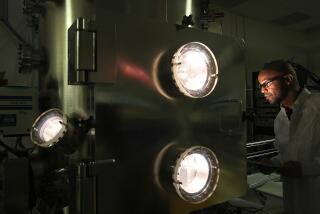What stays, and what goes, in Trump’s $19.1-billion budget proposal for NASA
President Trump’s $19.1-billion budget proposal for NASA will allow the space agency to continue its long-term efforts to explore the universe, including sending humans to the moon and to Mars.
The 2018 funding plan, released Tuesday, includes support for about 100 space missions even as it cuts some well-known programs, including one aimed at inspiring future generations of scientists and engineers.
For the record:
8:57 p.m. April 24, 2024An earlier version of this article attributed a reference to a “hobbled” Hubble Space Telescope to NASA Acting Administrator Robert M. Lightfoot Jr. The Hubble observatory is in good health, and that reference was incorrectly attributed to Lightfoot.
“We’ve got $19.1 billion as an agency, and it really reflects the president’s and the administration’s confidence in us,” said NASA’s acting administrator, Robert M. Lightfoot Jr., at a presentation to employees at the agency’s headquarters in Washington.
That level of funding will allow NASA to continue leading the world in space, he added.
The James Webb Space Telescope, one of NASA’s marquee projects, is set to launch next year, Lightfoot said. Also on track for 2018 are the Transiting Exoplanet Survey Satellite, or TESS, the Jet Propulsion Laboratory’s Mars InSight lander and Solar Probe Plus.
And, as it did in March, the budget plan largely allows NASA to continue its push for getting humans to Mars by the 2030s, Lightfoot said. In preparation, JPL will be sending a new rover to the Martian surface in 2020.
“What this budget tells us to do is keep going, keep doing what we’ve been doing,” he said.
However, the budget does away with the Asteroid Redirect Mission, a program based at JPL in La Cañada Flintridge that intended to capture a large asteroid and bring it close to Earth.
This mission was targeted in a White House budget blueprint in March and garnered mixed reactions. Some praised its intent, while others called it a distraction from the agency’s longer-term goals.
Lightfoot said some of the propulsion technology developed for the asteroid mission will be salvaged and put to other uses, including efforts to send humans to deep space.
The budget also follows through with a proposal to eliminate NASA’s Office of Education, which received an estimated $115 million in 2016.
That move was criticized by a group of U.S. senators who pointed to the office’s role in equipping students to enter science, technology, engineering and mathematics fields.
“Its mission is critical to boosting the nation’s workforce competitiveness,” the senators, led by Tim Kaine (D-Va.) and Tammy Baldwin (D-Wis.), wrote last week in an open letter to the Senate Appropriations Committee urging that the office be kept open.
Lightfoot said NASA would find other ways to engage and inspire educators and the public, including by carrying out its missions safely and successfully.
About 60 people would be affected by the cut, Andrew Hunter, NASA’s acting chief financial officer, said in a briefing. In general, these staffers would be placed in new positions in different parts of the agency.
“We won’t have any layoffs,” Hunter said.
Tuesday’s budget proposal confirmed the White House’s plan to cut several environmental science missions in development. These include:
- JPL’s Orbiting Carbon Observatory 3, or OCO-3, an instrument to precisely monitor the carbon dioxide in our atmosphere
- The Plankton, Aerosol, Cloud, ocean Ecosystem mission, or PACE, which was designed to monitor ocean health; and
- The Climate Absolute Radiance and Refractivity Observatory Pathfinder, or CLARREO, whose solar spectrometer would have produced highly accurate climate projections.
“There’s some hard things we had to do,” Lightfoot said.
The trimming of environmental science missions, many of which are rooted at JPL, worried Rep. Adam B. Schiff (D-Burbank), whose district includes the lab.
“A lot of the cuts are all directed to undermine efforts to understand how the planet is warming, and our capacity to determine what we ought to do about it,” Schiff said. “That’s probably my biggest concern about the budget vis-a-vis NASA.”
He praised the decision to fund the upcoming Europa Clipper mission, which would put an orbiter around Jupiter’s icy ocean moon. But the budget does not include money for a long-proposed Europa lander mission, which would allow NASA to directly explore the surface.
Europa is considered one of the prime spots to search for extraterrestrial life in the solar system; both missions would come out of JPL.
While the Trump administration’s initial budget plan included proposals to slash funding for the Environmental Protection Agency and the National Institutes of Health, NASA was largely spared. The new numbers served as a confirmation of that earlier vote of confidence, Lightfoot said.
“We are the leaders in human exploration,” he said. “That’s what we do.”
Follow @aminawrite on Twitter for more science news and “like” Los Angeles Times Science & Health on Facebook.
MORE IN SCIENCE
Cancer research, public health and worker safety would all see steep cuts under Trump budget
Rising sea levels could mean twice as much flood risk in Los Angeles and other coastal cities
UPDATES:
6:05 p.m.: The story has been updated to include information from Rep. Adam B. Schiff and acting NASA Chief Financial Officer Andrew Hunter.
The story was originally published at 11:55 a.m.







